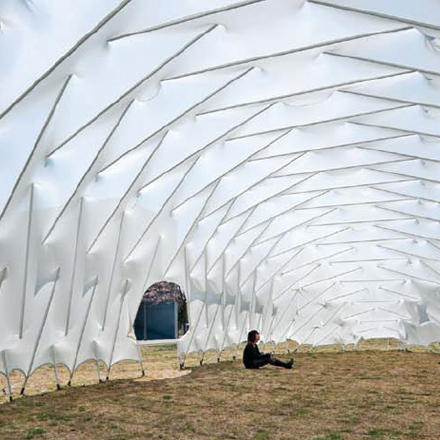Minimalistic Lightweight Construction: Temporary Pavilion in Noda

Architecture students from Tokyo developed an experimental, extremely lightweight, temporary pavilion structure – a tensegrity structure made of polyester membrane and aluminium struts. Two films give an impression of how the pavilion is set up.
Architects: Kazuhiro Kojima + Kojima Laboratory, Tokyo University of Science
Location: Tokyo University of Science, Noda Campus, Yamazaki, J-Noda
Architects: Kazuhiro Kojima + Kojima Laboratory, Tokyo University of Science
Location: Tokyo University of Science, Noda Campus, Yamazaki, J-Noda
The pavilion was set up in a joint effort by 70 students in one day. After laying out the prefabricated elastic polyester fabric membrane, aluminium struts were inserted in special pockets in the fabric. The structure was then pushed upwards from the inside, while the struts around the edges were held down and finally fixed to the ground with pegs. The concave and convex shapes created form a moving surface – an elusive stage for a lively interplay of light and shade.
About 80% of the UV radiation is shielded off by the membrane, while 50% of daylight is transmitted, resulting in a fascinating interior atmosphere of soft filtered light. At night, the translucent pavilion turns into a light sculpture illuminated from the inside. After being used for seminars on the university campus for one week, the structure was disassembled and stored for next use.
About 80% of the UV radiation is shielded off by the membrane, while 50% of daylight is transmitted, resulting in a fascinating interior atmosphere of soft filtered light. At night, the translucent pavilion turns into a light sculpture illuminated from the inside. After being used for seminars on the university campus for one week, the structure was disassembled and stored for next use.
